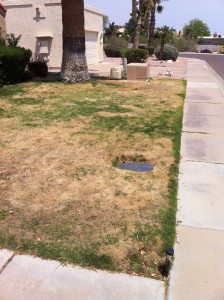May
Transition is in Full Swing
Let me save you the time from watching the weather forecast over the next 4 months and we can all just say it is going to be HOT! Yes we will see a few days under triple digits but the majority of them will be above 100 and the Bermudagrass and Paspalum are going to start taking over and pushing the winter Ryegrass out.
We are seeing soil temperatures that are favorable for warm season growth and with a little bit of time you can make this a painless transition process. If you opted not to overseed your lawn last year I am sure by now you’ve mowed the grass plenty of times and are starting to see it develop into a lush turf. The idea is to keep your lawn perfect and not get behind by forgetting to add fertilizer and a great choice with overseeded or non overseeded turf is the Soil Burst 5-15-10. The magnesium, calcium, and iron will jump start your lawn and get it the right nutrients to have a healthy start to the year. Below you will find instructions on making sure you have a good transition and your lawn stays healthy as the weather changes.
Step By Step Transitioning
1. Gradually lower your mowing heights to reduce the turf canopy. Warm season grasses are not shade tolerant and excess ryegrass provides shade. No need to scalp the lawn, just lower the height down and begin to thin out the grass.
2. Lightly verticut the lawn to open up the canopy and let sunlight into the grass below.
3. Be careful of fertilizer rates at this time of the year and stick to slow release products such as Soil Burst 4-0-6, 7-7-7, or 16-0-4. These can be applied in low nitrogen doses and will keep your lawn dark green (1.5 qts/1000 SF).
4. If you have standing water it is a great time to aerify so you can help air and water better infiltrate the soil.
5. Increase your mowing frequency to two times per week to reduce turf canopy.
6. Gradually back off the water in April and May to stress out the ryegrass when soil temperatures reach 64 degrees (usually around mid April). Turning off the water completely will stress out the warm season turf and ryegrass so this is not the optimal approach. Use 70% of your normal water rate.
7. When soil temperatures reach 64 degrees apply Soil Burst 5-15-10 at 20 pounds per 1000 SF to give the grass a jump start on the year.
8. Enjoy the beautiful summer lawn!
Watering
Let’s talk about how much you need to be watering to get your grass growing and properly transitioned. As I have been preaching for the last few years you do not want to just turn your water off for a week to ten days and kill the ryegrass because you are also stunting the growth of the bermudagrass. All grasses need water to survive so cutting off water only causes you to have more issues with your lawn. During the summer you should use between 1” and 1 ½” of water per week and that can be broken up into 3-4 days depending on your soil type. During this time of the year you want to use 70 percent of that amount so your bermudagrass/paspalum thrives and the ryegrass begins to choke itself out. Over a couple weeks of this practice, lower mowing heights, and opening up the turf canopy with a verticutter you will transition very quickly. It does not take much for your warm season grass to take off and begin to grow but if you have too healthy of ryegrass you are putting the equivalent of a shade canopy over the turf.
Lots of people often ask if verticutting is the same thing as dethatching and the answer is no. While they are similiar the cultural practice of each is slightly different. To verticut a home lawn you would use a self propelled unit that utilizes vertical blades to help thin out the turf canopy. You set this machine to run through the grass leaf tissue and it never affects the root system. Thinning out the turf canopy allows light in, helps the grass use less water, and most of all it gives your grass new growing points.
Dethatching is the process of removing built up organic matter. This is a process that usually needs to be done every three to four years and it is similiar to a verticut except it cuts much deeper into the soil. it is extremely important when operating this machine that you don’t go so deep that you’re pulling up root mass. Dethatching should be done during the summer months when the grass is actively growing and when you have an extreme spongy feel to your turf.
At this time of the year we battle through some tough visual periods with our lawns but there is no reason to be concerned unless you’re just seeing dirt. The yellow to brown tinge is the ryegrass starting to die out and it takes some time for the bermudagrass or paspalum to overtake it. This is not an instant process and you should keep in mind that having dead material on top of your bermudagrass is providing shade and warm season grasses hate shade. This is why it is good to verticut or rake up any dead material and allow the sunlight to get into the plant so it can grow.
Last but not least remember everyone will go through this painful process including high end million dollar golf courses so don’t worry about seeing some brown grass.


